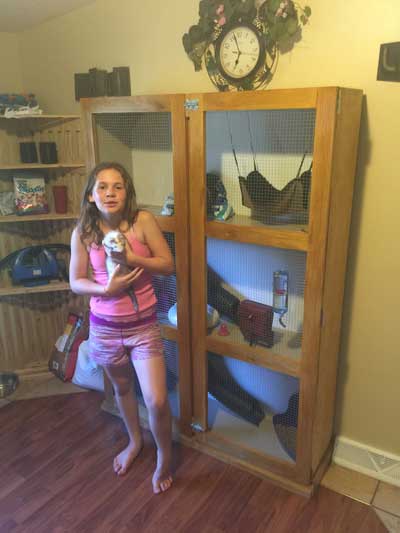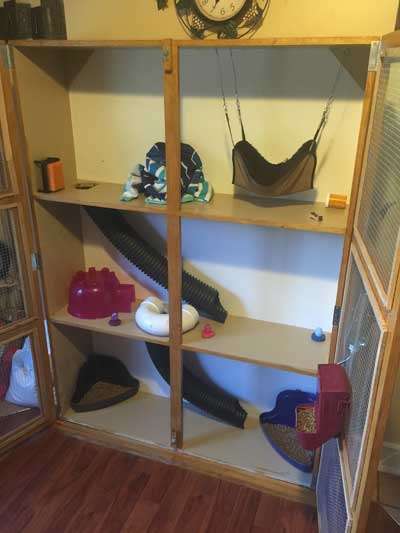In last week’s eZine editorial, Rob mentioned that he’s seen the size of his woodworking projects decrease with his advancing years. He wondered if eZine readers had noticed a similar trend. (And we had at least one who sympathized with the “aircraft carrier” size of a project from Rob’s younger days.) – Editor
“I will tell you what I managed to do. About five months ago, my daughter bought a ferret. It was from the pet store and not very old. I did some research on custom ‘cages.’ I wanted more of a habitat of sorts. I figured this rat would be active and want something to do when my daughter is unavailable to play with her. I took to the iPad and looked up some pictures of what others had done. I saw a lot of people that took crappy knockdown faux cupboards and bookshelves, threw on some chicken wire, and life was good. So, not wanting to redneck something together, I thought ‘I can do it better.’ I took some measurements of the ferret. Side note: have you ever tried to measure a young ferret that cannot stay still? I still don’t know why I measured it, it’s just long and low. So I decided on 4 feet wide, 5 and ½-inch tall and 2 feet deep, and it will have three levels with each level having an obstacle course-like play area. So off I go for some plywood. Two: 4x8x3/4″ sheets and 1 sheet of 1/2″ for the back. I got the pieces home and broke down per my cutlist and dry assembled it on the floor. That is the first time I built anything this size and decided it would be good to dry assemble first. Once dry fitted I stood back and thought, that seems big enough fora gaggle of ferrets. So I left it alone until my wife woke up for work (thridrd shift) to take a look at it and give her input. So I ended up splitting the whole thing in half and making it only one foot deep. I guess the good thing is I now have enough to build the carcass for a second cage. Maybe I will make it a vacation spot for her ferret.” – Kevin Hanes
“I began woodworking and woodturning with small projects, because I did not want to ruin a large piece of wood. As a result, I learned the importance of accuracy and attention to detail. Although I have completed larger projects, I still prefer to work on small items, where avoiding the smallest errors makes the difference between a good finished product and a great one.” – Jennifer Wilson
“I understand the moving of plywood around the shop. There was a time when I would be able to have my wife stand at one end of the arm saw and balance the wood as I pushed it through. Now, at age 73, it isn’t as easy. I love building furniture, I have a great time doing it and giving it to the family. I have furnished the wood furniture for two daughters and a son. A few years ago, the art of building a desk was easy. I didn’t have a problem lifting and moving around one of the pedestals from workbench to floor and back again. Now, if there is something that size, I need to call my neighbor to help. I have taken up the hobby of turning small items like pens and bottle stoppers, but it is not the same. I like the small objects as they are completed in an hour or less. The problem is I now have about 40 pens and 20 bottle stoppers without a home.” – John Schelby
“My project sizes around my house tend to be small at this point. I built a pot rack for my daughter recently for her new apartment. I’m a new beginner to woodworking, so small is nice right now. I will eventually graduate up to bigger projects in the future with more skills and tools that I acquire.” – David Drier
“Years ago, I got my first lathe, driving it with an old refrigerator motor. I immediately became addicted to turning. I have moved up a few lathe generations now. As an almost exclusive turner I don’t need much ¾-inch plywood. Why not do more turning? Even relatively large bowl blanks can be handled easier than a sheet of plywood. Besides, every now and then you get a chance to harvest some wood when trees are being cut nearby. That gives you a chance to use your chainsaw. All that power, what fun!” – James Yarbrough
“My projects are definitely getting smaller. When I was younger, I renovated and restored old wood yachts and sailboats, some as large as 60 feet. Afterwards I built a lot of furniture – much easier on the back. Building furniture is now strictly reserved for my home. When I started doing shows, my focus was creating much smaller projects, primarily wood sculpted boxes. My philosophy now is creating work I can easily pick up and carry. With 30 to 40 boxes, some moving quilts for protecting them, and a bunch of Rubbermaid containers, I am off to have fun at the art shows.” – Greg Little
“As I grow older (I’m a child of the Great Depression), I tend to think small, but seem to fall into snares that require larger dimensions. Because of that, I resort to using wheels and whatever else will help me hoist the big stuff. When all else fails, I call for help. That said, I do prefer the small projects whenever possible.” – Don Butler
“I started with a full wall cabinet and Murphy bed, one big project. I switched to building floor clocks as they were much easier to handle. With my age increasing and my strength decreasing, I switched to mantle clocks. With the development of Myasthenia Gravis, my strength decreased greatly, and now I have switched to bird carving. I guess the only place to go from here is making toothpicks, but I am not giving up woodworking.” – Mark Woodcock







